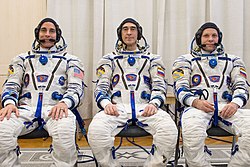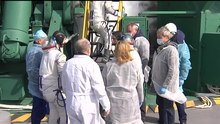Soyuz MS-16
| Mission emblem | |||
|---|---|---|---|

|
|||
| Mission dates | |||
| Mission: | Soyuz MS-16 | ||
| Spacecraft: |
Soyuz 7K-MS ( GRAY index 11F747) serial number 745 |
||
| Launcher: | Soyuz-2.1a (GRAY index 14A14) | ||
| Call sign: | Иркут (" Irkut ") | ||
| Crew: | 3 | ||
| Begin: | April 9, 2020, 8:05 am ( UTC ) | ||
| Starting place: | Baikonur 31/6 | ||
| Space station: | ISS | ||
| Coupling: | April 9, 2020, 14:15 (UTC) | ||
| Decoupling: | October 21, 2020 (planned) | ||
| Duration on the ISS : | 195 days (planned) | ||
| Landing: | October 22, 2020 (planned) | ||
| Landing place: | Kazakhstan | ||
| Team photo | |||
 Chris Cassidy, Anatoli Iwanischin and Iwan Wagner |
|||
| ◄ Before / After ► | |||
|
|||
Soyuz MS-16 is a flight of the Russian Soyuz spacecraft to the International Space Station (ISS). As part of the ISS program, the flight is designated ISS AF-62S. It is the 168th flight in the Soyuz program and the 62nd visit by a Soyuz spaceship to the ISS.
Mission description
The mission brought three members of ISS Expeditions 62 and 63 to the space station. The Soyuz-2.1a rocket version was used for a manned flight for the first time. It replaces the Soyuz-FG , which was retired after the start of the Soyuz MS-15 mission .
crew
Main crew
- Anatoly Iwanischin (3rd space flight), Commander ( Russia / Roscosmos )
- Iwan Wagner (1st spaceflight), flight engineer (Russia / Roskosmos)
- Chris Cassidy (3rd spaceflight), flight engineer ( USA / NASA )
Initially, the JAXA astronaut Akihiko Hoshide was scheduled to be the second flight engineer and commander of ISS Expedition 63 . Due to delays in the completion of the new US spaceships Crew Dragon and CST-100 Starliner , it was exchanged for Cassidy as a precaution. This will ensure that the American segment of the space station will continue to be occupied by an American after the Soyuz MS-15 undocked with Jessica Meir and Andrew Morgan .
Nikolai Tichonow and Andrei Babkin were supposed to fly for Roskosmos first . However, due to an eye injury by Tikhonov, they were replaced by Ivanishin and Wagner in February 2020; Babkin was assigned to the new substitute team.
Substitute team
- Sergei Ryschikow (2nd space flight), Commander (Russia / Roskosmos)
- Andrei Babkin (1st spaceflight), flight engineer (Russia / Roskosmos)
- Stephen Bowen (4th spaceflight), flight engineer (USA / NASA)
Mission history
Because of the COVID-19 pandemic , the crew members spent four weeks in quarantine instead of the usual two weeks . The isolation measures were stricter than usual; so the spacemen had to say goodbye to their relatives beforehand.
The spacecraft was launched into Earth orbit on April 9, 2020 with a Soyuz 2.1a rocket from the Baikonur Cosmodrome . It reached the ISS after a six-hour flight.
gallery
See also
- List of Soyuz missions
- List of manned missions to the International Space Station
- List of manned space flights
Web links
- Soyuz MS-16 at spacefacts.de
- Soyuz MS-16 on the Russian Space Web
- ISS Expedition 63 on Spacefacts.de
- Утвержден экипаж космического корабля "Союз МС-16" . TASS, June 27, 2019 (Russian)
Individual evidence
- ↑ a b Chris Gebhardt: Russia conducts first Soyuz 2.1a human launch; MS-16 crew to station . Nasaspaceflight.com, April 9, 2020 (English).
- ↑ Chris Gebhardt: Russia conducts first Soyuz 2.1a human launch; MS-16 crew arrives at station . Nasaspaceflight.com, 8./9. April 2020 (English).
- ↑ SMSR Integrated Master Schedule . NASA, April 27, 2020.
- ↑ Upcoming ISS Expeditions . Spacefacts.de, accessed on April 9, 2020 (English).
- ↑ Russia replaces cosmonauts on next ISS crew for 'medical reasons' . Collectspace, February 19, 2020 (English).
- ↑ Joseph Navin: Preparations continue amid crew shuffle for Soyuz MS-16 . Nasaspaceflight.com, March 4, 2020 (English).
- ↑ Space mission: On the way to the ISS in Corona times. tagesschau.de , April 9, 2020, accessed April 10, 2020 .
- ↑ Loren Grush: Three astronauts are launching to space Thursday after lengthy quarantine. In: The Verge. April 8, 2020, accessed April 10, 2020 .





